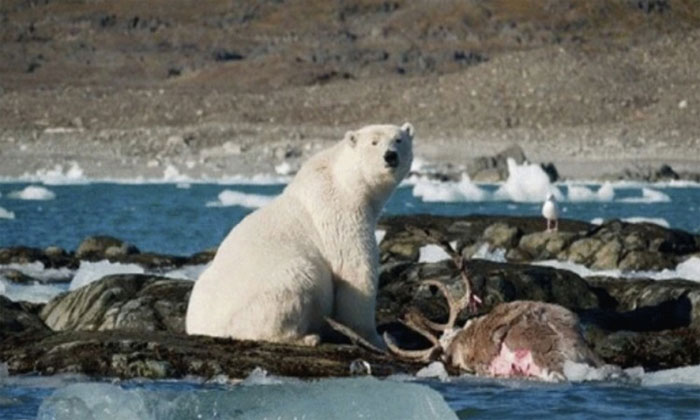Endangered Polar Bears are Shifting to Land-Based Caribou Hunting Instead of Seals Due to Declining Sea Ice.
The process of Polar Bears hunting and killing caribou. (Video: Mateusz Gruszka)
Biologists at the Polish Polar Station on the Svalbard Archipelago in Norway shared the first video capturing Polar Bears hunting and feeding on caribou, filmed in August 2020. At that time, an adult female Polar Bear was seen following a group of caribou. The caribou attempted to escape the predator by swimming across the Isbjørnhamna Bay. However, the Polar Bear took just over a minute to catch up with its prey, subdue it, and drag it ashore.
The research team believes this behavior is not only a result of declining sea ice but also due to the significant increase in caribou populations in the Arctic over the past three decades, making them more accessible to endangered Polar Bears. The caribou population has increased since 1973 when the federal government listed them for protection. According to researchers, prior to 2000, Polar Bears did not attack Svalbard caribou. The paper published on October 12 in the journal Polar Biology is the first comprehensive document describing the entire hunting behavior of an adult Polar Bear on caribou in Hornsund, southwestern Spitsbergen.
The paper also includes at least 12 reports from passersby who witnessed Polar Bears hunting or feeding on caribou. The research team stated that there is evidence of increasingly common attacks. They recorded an attack on August 21, 2000, but only recently shared the video. The Polar Bear appeared about 100 meters from the Polish Polar Station. Some scientists ventured out to observe the wild animal more closely. They noted that it was moving toward the coastline of Isbjørnhamna Bay, where a group of caribou was grazing.

A Polar Bear drags the lifeless body of a caribou ashore and begins to tear apart its prey.
Most of the caribou were scattered, but one of them caught the bear’s attention. The caribou dared to swim out into the bay. The Polar Bear accelerated in pursuit and jumped into the cold water after its potential prey. Ultimately, it caught up with the caribou when it was about 25 meters from shore. It used its claws to grip the caribou’s flank, forcing the prey to stop swimming and climbed onto its back to drown it.
“The prey and the attacker struggled for a moment. Each animal alternated surfacing for air. Then, the Polar Bear grabbed the caribou’s neck from underneath and killed it within a minute. It flipped the caribou’s body over, drowning the prey multiple times over approximately 15 minutes, even though the caribou was already dead,” the research team described.
After the life-and-death struggle, the Polar Bear dragged the lifeless body of the caribou ashore and began to tear apart its prey. Next, it used stones to cover the remaining carcass to prevent other predators from approaching, choosing a nearby spot to sleep for 12 hours before returning to its meal. However, foxes and birds still took the opportunity to peck at the remaining carcass while the bear slept. By the next afternoon, the bear alternated between lying near the carcass and eating the remaining meat. It consumed about 80% of the caribou’s flesh.


















































